Sony A5100: settings, tips and tricks
Sony A5100: settings, tips and tricks
Introduction
The Sony A5100 has the same APS-C sensor and dual on-sensor phase/contrast detection AF as the highly regarded A6000. In fact, one of the few differences is that this model does not have a viewfinder. Instead, it has a touch-sensitive screen that allows you to focus and capture images with a touch of your finger on the screen.
Although this is a relatively easy camera to use, it is still very customizable, and this might seem daunting at first.
No worries, I’ve assembled a guide to the essential functions of the Sony A5100, including some tips and tricks.
First things fist: setting up your camera for your use and getting to know the MENU system.
Diving into the MENU system
When you switch on your camera, you’ll be asked to enter a date, time and timezone. This setting is necessary, as all images captured will have a timestamp, making it easy to find your favorite pictures in the future.
After this is setup, press the MENU button. You’ll see a range of icons and pages.
We’ll start at page 1 of the camera Icon (camera settings)
(MENU → Camera Settings → page 1)
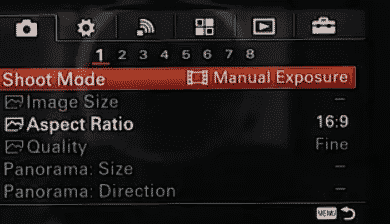
Shoot Mode:
- Intelligent Auto (i)
The Intelligent Auto mode will automatically detect the type of scene you are shooting and adjust accordingly. Once detected, an icon for the recognized scene will appear in the top right-hand corner of the screen.
Useful for: all-around shooting when you want to simply snap off some photos, with less emphasis on composing a specific desired shot. - Superior Auto (i+)
Superior Auto goes beyond scene type detection, including composite layering for higher dynamic range. Available only when shooting JPEG only.
Useful for: Similar situation as Intelligent Auto, but when the scenes you are shooting include a wide range of exposure, such as shooting into or out of the shadow. - Program Auto (P)
In Program, the camera automatically sets the shutter speed and aperture, leaving the exposure adjustments left to you.
Useful for: intentionally creating under or overexposed photos. - Aperture Priority (A)
Aperture Priority gives you manual control of the aperture of your camera while automatically setting shutter speed and exposure. Adjusting the aperture gives you control of how much of your shot is in (or out of) focus.
Useful for: controlling the depth of field of your photos, to either isolate your subject by blurring more of the shot, keeping more of the frame in focus. - Shutter Priority (S)
Shutter Priority automatically locks in the exposure and aperture for you, and you manually control the shutter speed. This is a great creative tool to either add or subtract movement from your shots by using slower or higher shutter speeds, respectively.
Useful for: when you want to add or remove motion in your photos by slowing or speeding up the shutter speed. - Manual Exposure (M)
Manual Exposure puts you in control of all three of the main adjustments: shutter speed, aperture, and ISO. Auto ISO can be used in Manual mode.
Useful for: control freaks. Or simply in situations when you know better than (the automatic adjustments made by) your camera. - Movie (film icon)
Although capturing video is available in any mode using the MOVIE button to begin recording, setting the camera to Movie mode makes changing video record settings easier. There are four shooting modes within video mode. In Movie mode, press the Select button to switch between:- Program Auto automatically selects shutter speed and aperture, leaving the exposure adjustment to you.
- Aperture Priority gives you control of aperture while setting exposure and shutter speed automatically.
- Shutter Priority, as you might expect, adjusts exposure and aperture, leaving you to adjust shutter speed.
- Manual Exposure, finally, gives you control of all three: exposure, aperture, and shutter speed.
- Sweep Panorama (pinched-in rectangle icon)
Sweep Panorama is a built-in panoramic photo creation mode. With Sweep Panorama shooting mode selected, press the shutter button, then slowly rotate the camera to the right. The camera will take multiple photos and stitch them together into a single, ultra-wide panoramic photo.
Useful for: Capturing more than what a single frame can offer. - Scene Selection (SCN)
Scene Selection lets you select the scene type that is most like the environment you are shooting.
Useful for: getting the benefits of auto mode in a known scene setting.
Scene types include:- Portrait
- Sports Action
- Macro
- Landscape
- Sunset
- Night Scene
- Hand-held Twilight
- Night Portrait
- Anti-Motion Blur
Image size:
The larger the image size, the more detail will be reproduced when the image is printed on large-format paper. The smaller the image size, the more images can be recorded.
Image size when the aspect ratio is 3:2:
- L: 24 megapixels or 6000×4000 pixels
- M: 12 megapixels or 4240×2832 pixels
- S: 6.0 megapixels or 3008×2000 pixels
Image size when Aspect Ratio is 16:9
- L: 20 megapixels or 6000×3376 pixels
- M: 10megapixels or 4240×2400 pixels
- S: 5.1megapixels or 3008×1688 pixels
Please note that when Quality is set to RAW or RAW & JPEG, the image size for RAW images is automatically set to L for optimal quality.
If SD card space is an issue, you can set it to Small.
Aspect ratio:
You can choose 3:2 (which uses the full sensor surface) or 16:9 (crop but a more broad view). Leave as is at 3:2, you can always crop your pictures later.
Quality:
Do you edit your pictures on your desktop? If so, set to RAW or RAW+jpeg. A RAW file saves all information the camera pixels register during shooting and will make for better quality images if you want to edit in something like Adobe Lightroom.
A RAW file saves all information the camera pixels register during shooting and will make for better quality images if you want to edit in something like Adobe Lightroom.
A jpeg is a compressed image (available in FINE (larger) and STANDARD (smaller, less quality) which takes up less space on your SD card but is less suited for editing afterward. Jpeg images will also have in-camera noise reduction applied, something you might or might not want to take care of yourself later, depending on your use.
Jpeg images will also have in-camera noise reduction applied, something you might or might not want to take care of yourself later, depending on your use.
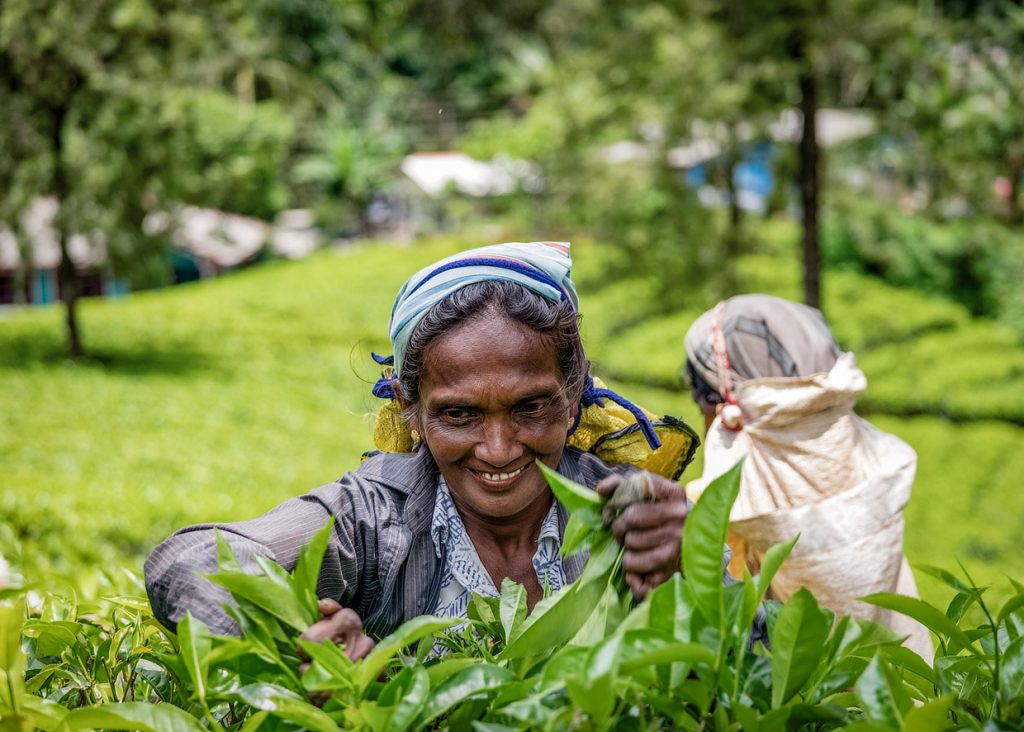
Panorama size
(Only available when in panorama shooting mode) Size is selectable between standard and wide. Wide means your picture will cover a larger area. Set it to standard, having to scan an even broader area when making panoramas will take some experience with the camera to do efficiently.
Size is selectable between standard and wide. Wide means your picture will cover a larger area. Set it to standard, having to scan an even broader area when making panoramas will take some experience with the camera to do efficiently.
Set it to standard, having to scan an even broader area when making panoramas will take some experience with the camera to do efficiently.
Panorama direction
A panorama picture (only available in jpeg) is a composite of several images stitched together. When in this mode, you’ll see an arrow that guides you in what direction and speed you should pan the camera to take the sequential images that will be stitched together. You can choose the path in this menu (either, up, down, left or right).
You can make panoramas while scanning your camera up-down or left-right.So what is this all about? This might sound confusing at first, but this comes down to how you hold the A5100 when shooting panoramas: either in portrait or landscape orientation.
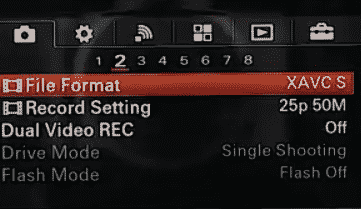
(MENU → Camera Settings → page 2)
File Format
This is where you select what file format you want to use for video.
These are your options:
- XAVC S: Records HD movies in XAVC S format. This file format is suitable for high bit rates. Audio is recorded as LPCM. (Note: You cannot create discs using the software PlayMemories Home with movies that are recorded with File Format set to XAVC S. If you want to record movies with File Format set to XAVC S, you need an SDXC memory card with a capacity of at least 64 GB (Class 10 or faster), a UHS-I compatible SDXC memory card with at least 64 GB, or a Memory Stick XC-HG Duo media)
- AVCHD (default setting): Records HD movies in AVCHD format. This file format is suitable for high-definition TV. You can create a Blu-ray Disc, an AVCHD recording disc, or a DVD-Video disc using the software PlayMemories Home. Audio is recorded in Dolby Digital
- MP4: Records mp4 (AVC) movies. This format is suitable for WEB uploads, e-mail attachments, etc. Audio: AAC
AVCHD is a far superior codec than plain MPEG-4. AVCHD is based on MP4 but is a much cleaner, much more advanced.
Record setting
Also for video functionality only. You can choose the quality of recorded video here. You can change the image size, frame rate, and image quality for movie recording. The higher the bitrate, the higher the image quality. If you’re not familiar with this, leave as is.
When File Format is set to XAVC S:
- This records high-definition movies by converting them to MP4 file format using the MPEG-4 AVC/H.264 codec.
When File Format is set to AVCHD:
- 60i/50i: Movies are recorded at approximately 60 frames/sec (for 1080 60i-compatible devices) or 50 fields/sec (for 1080 50i-compatible devices). Also in interlaced mode, with Dolby Digital audio, in AVCHD format.
- 24p/25p: Movies are recorded at approximately 24 frames/sec (for 1080 60i-compatible devices) or 25 frames/sec (for 1080 50i-compatible devices). Also in progressive mode, with Dolby Digital audio, in AVCHD format.
- 60p/50p: Movies are recorded at approximately 60 frames/sec (for 1080 60i-compatible devices) or 50 frames/sec (for 1080 50i-compatible devices). Also in progressive mode, with Dolby Digital audio, in AVCHD format.
When File Format is set to MP4:
- Movies shot are recorded in MPEG-4 format, at approximately 30 frames/sec (for 1080 60icompatible devices) or about 25 frames/sec (for 1080 50i-compatible devices), in progressive mode, with AAC audio, mp4 format.
Menu items details:
When File Format is set to XAVC S:
- 60p 50M*/50p 50M** (default setting): Records high image quality movies at 1920 × 1080 (60p/50p). Bit-rate: Approx. 50 Mbps (Avg.)
- 30p 50M/25p 50M**: Records high image quality movies at 1920 × 1080 (30p/25p). Bit-rate: Approx. 50 Mbps (Avg.)
- 24p 50M (Only for 1080 60i compatible models): Records high image quality movies at 1920 × 1080 (24p). This produces a cinema-like atmosphere. Bit-rate: Approx. 50 Mbps (Avg.)
When File Format is set to AVCHD:
- 60i 24M(FX)*: 50i 24M(FX)**: Records high image quality movies of 1920 × 1080 (60i/50i). Bit-rate: Approx. 24 Mbps (Max.)
- 60i 17M(FH) (default setting)*: 50i 17M(FH) (default setting)**: Records standard image quality movies of 1920 × 1080 (60i/50i). Bit-rate: Approx. 17 Mbps (Avg.)
- 60p 28M(PS)*:
- 50p 28M(PS)**: Records the highest image quality movies of 1920 × 1080 (60p/50p). Bit-rate: Approx. 28 Mbps (Max.)
- 24p 24M(FX)*: 25p 24M(FX)**: Records high image quality movies of 1920 × 1080 (24p/25p). This produces a cinema-like atmosphere. Bit-rate: Approx. 24 Mbps (Max.)
- 24p 17M(FH)*: 25p 17M(FH)**: Records standard image quality movies of 1920 × 1080 (24p/25p). This produces a cinemalike atmosphere. Bit-rate: Approx. 17 Mbps (Avg.)
When [ File Format] is set to MP4:
- 1440×1080 12M (default setting): Records movies of 1440 × 1080. Bit-rate: Approx. 12 Mbps (Avg.)
- VGA 3M: Records movies of VGA size. Bit-rate: Approx. 3 Mbps (Avg.) *
- Notes:* 1080 60i (NTSC) compatible device, ** 1080 50i (PAL) compatible device
General notes:
- 60p/50p movies can be played back only on compatible devices.
- Movies recorded with the [60p 28M(PS)]/[50p 28M(PS)]/[60i 24M(FX)]/[50i 24M(FX)]/ [24p 24M(FX)] /[25p 24M(FX)] setting in [ Record Setting] are converted by PlayMemories Home in order to create an AVCHD recording disc. This conversion can take a long time. Also, you cannot create a disc in the original image quality. If you want to keep the original image quality, store your movies on a Blu-ray Disc.
- To play back 24p/25p movies on a TV, the TV must be compatible with the 24p/25p formats. If the TV is not compatible with the 24p/25p format, 24p/25p movies will be output as 60i/50i movies.
- You cannot create discs with movies recorded with [XAVC S] or [MP4] recording settings using PlayMemories Home.
Dual Video Rec
This allows you to simultaneously record an XAVC S movie and an MP4 movie, or an AVCHD movie and an MP4 movie. ON or OFF.
When Record Setting for an XAVC S movie is set to 60p/50p, Record Setting for an AVCHD movie is set to 60p/50p, or File Format is set to MP4, the Dual Video REC function is set to Off.
If you select Date View in View Mode when playing back movies, XAVC S movies and MP4 movies, or AVCHD movies and MP4 movies are displayed side-by-side.
If you’d like to get more into flash photography, this is a fundamental explanation of the possible modes:
fill flash: A fill flash is useful even in daylight to fill the shadows with light (like a person in the shade).
Drive Mode
You can set the drive mode, such as continuous or self-timer shooting.
- Single Shooting (default setting): Shoots one still image. Normal shooting mode.
- Cont. Shooting: Shoots images continuously while you press and hold down the shutter button. Hi: takes about six images per second, Lo about 3
- Self-timer: Shoots an image after 10 or 2 seconds. (selectable in sub menu) You can change the angle of the LCD screen and shoot images while monitoring the image on the screen.
- Self-timer(Cont): Shoots a specified number of images continuously after 10 seconds or 2 seconds (selectable in the sub menu).
- Cont. Bracket: Shoots images while holding the shutter button down, each with different degrees of brightness. (from 3 to 5 images with between .3 and 3 EV difference, selectable in the sub menu.) For processing as HDR on your PC.
- Single Bracket: Shoots a specified number of images, one by one, each with a different degree of brightness. (from 3 to 5 images with between .3 and 3 EV difference, selectable in the sub menu) For processing as HDR on your PC.
- WB bracket: Shoots a total of three images, each with a different color tone according to the selected settings for white balance, color temperature, and the color filter. (3 images with either LO small changes or Hi large changes)
- DRO Bracket: Shoots a total of three images, each at a different degree of D-Range Optimizer.
Flash Mode
Flash off;
obvious
Autoflash:
The flash works in dark environments or when shooting towards a bright light.
Fill-flash:
The flash works every time you trigger the shutter.
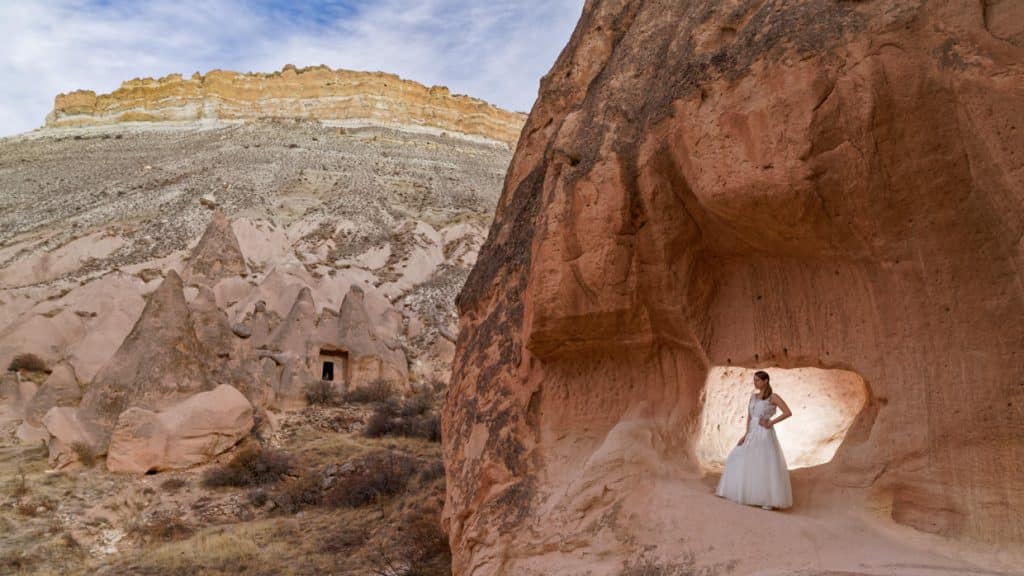
Slow sync:
Tells the camera to use a longer shutter speed along with a flash, and thus is better for night shots. In manual and shutter priority modes, there is no difference in flash power. But when using aperture priority, program, or auto, choosing slow sync tells the camera to use a longer shutter speed than it would ordinarily pick.What the slow sync flash mode actual does is first fire the flash for the subject exposure, then allow for a longer shutter speed that will allow for more ambient light to be captured by the sensor.
Rear Sync:
Capturing an image involves two shutter actions: one when the capture starts and on when it stops. Rear Sync tells the flash to fire right before the shutter closes. Moving objects will show a streak where they came from and a sharp image where they were at the end of the exposure. This conveys a sense of speed with moving objects. Rear Sync is a creative technique, if you’d like to know more about this type of photography, I’d suggest doing a Google search on ‘Rear Sync Flash Photography.’
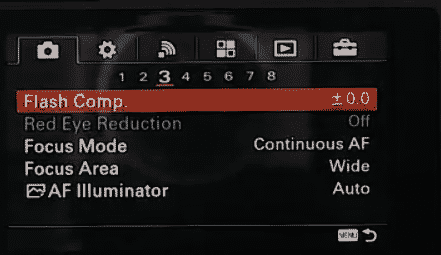
(MENU → Camera Settings → page 3)
Flash compensation:
Especially when using Slow Sync or Rear Sync Flash modes, you might have to lower the power of the Flash to get a decently exposed image.
Red Eye Reduction:
This anti-Red Eye setting quickly fires the flash before your image capture starts, reducing the red-eye effect often seen when using a flash
Focus Mode
Here, you can select how the autofocus engine will behave when you half-press the shutter button. Novice users should set into AF-A. This functionality is partly dependent on what focus area you select (see next)
AF-S:
With a half-press of the shutter button, the camera will focus only once. Suitable for capturing stills.
AF-A:
AF Automatic intelligently switches between S and C, depending on whether the camera detects movement or not. This is the standard setting and the easiest to use.
AF-C:
The camera will continuously focus on any movement when you half-press the shutter button.
DMF:
The ILCE-5100 focuses on your subject and allows you to fine tune your focus area further using the manual focus ring on the lens.
MF:
No autofocus is used, and you focus manually using the focus ring on the lens.
Focus area
The Sony A5100 sensor has a dual phase/contrast detect system embedded in the sensor itself. With 179 points (phase-detection AF) / 25 points (contrast-detection AF). This makes it one of the fastest and most reliable AF systems in a compact camera and is even better than some AF systems in cameras that cost over three times as much. You might think it is best to leave it on the factory ‘wide’ setting (as this uses all AF points), but for certain scenes, it is often better to use a zone or flexible spot to get it to focus on what you want.
Wide:
Wide focus area uses all focus points on the sensor. Ideal for action scenes where there is a lot of movement going on in your frame.
Zone:
Zone allows you to select one of 9 predefined zones where autofocus will be active. These zones each cover about 25% of the screen, with a slight overlap. You can quickly change the zone by pressing the multi-controller button and navigating to any of the other zones.
Center:
Focusses on whatever is centered in your images. A fail-proof way of getting the camera to focus on what you want. If you have any problems using the autofocus and are in a situation where you don’t want to miss any shots, revert to Center and just make sure you have your subject centered.
Flexible spot:
Flexible spot area selects a spot anywhere on the screen where the camera should focus. (similar to Center spot, except not.. in the center) You can set it to small, medium or large. If you want to use this focus area, set it to medium or large, as the camera will struggle to find focus when set to small (except perhaps for close-up portraits where you’d want to focus on the iris of the eye)
Lock-on AF:
When the shutter button is pressed and held halfway down, the product tracks the subject within the selected autofocus area. Point the cursor to [Lock-on AF] on the [Focus Area] setting screen, then select the desired tracking start area using the left/right sides of the control wheel. You can move the tracking start area to the desired point by designating the area to be the flexible spot. On the Flexible Spot shooting screen, you can change the size of the AF range finder frame by rotating the control wheel.
AF Illuminator:
The AF illuminator is a little red light allowing the camera to focus more easily when the shutter button is pressed halfway. It automatically is switched off when you fully press the shutter. Leave it on.
(MENU → Camera Settings → page 4)
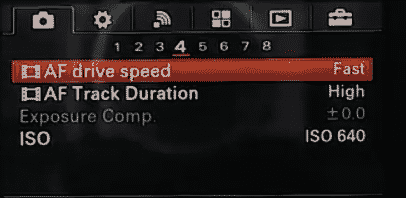
AF Drive speed (Movie mode):
You can select the autofocus speed to Fast, Normal or Slow. You might think faster is better, but in real life, you’ll often find that Fast focusses on any slight movement and that it’s best to set it to Normal or Slow.
If you find that the Sony A5100 does not focus fast enough for your needs, this setting and the next are worth experimenting with, though.
AF track duration (Movie mode):
High is useful when recording movies with fast action scenery. The Normal mode works fine in most situations.
Exposure Comp
If you find that your image is overexposed (for instance when you are shooting at large apertures for a shallow depth-of-field in bright daylight), you can tweak the exposure compensation here in a plus or minus 5 (exact EV dependent on next step) range.
Exposure Step:
This determines the Exposure Compensation levels, selectable between 0.5EV and 0.3EV steps
ISO
You can select at which ISO value you’d like to capture your image or change the AutoISO range
I have this range set between 100-1600 as this range is virtually noise free, and I don’t like the ISO performance above 1600. If you’re a jpeg shooter (and use built-in Noise Reduction), you might think of using a higher top value (factory setting goes up to 6400).
(MENU → Camera Settings → page 5)
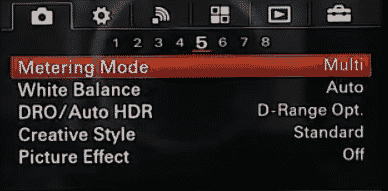
Metering Mode
Metering mode refers to the way the camera reads the light and sets the exposure.
In multi, it considers the whole frame and sets exposure according to internal algorithms programmed in camera.
In spot or center, the camera only considers what is in that spot or the center (per example, if your subject is completely black, the camera will try to compensate by overexposing the image).
White Balance
You can either:
- Auto (default setting): The product automatically detects the light source and adjusts the color tones.
- Daylight: The color tones are adjusted for the daylight. Shade: The color tones are adjusted for shadiness.
- Cloudy: The color temperature is adjusted for a cloudy sky. Incandescent: The color temperature is adjusted for places under an incandescent lamp, or under bright lightings, such as in a photo studio.
- Fluor.: Warm White: The color temperature is adjusted for warm white fluorescent lighting.
- Fluor.: Cool White: The color temperature is adjusted for white fluorescent lighting.
- Fluor.: Day White: The color temperature is adjusted for neutral white fluorescent lighting.
- Fluor.: Daylight: The color temperature is adjusted for daylight fluorescent lighting.
- Flash: The color temperature is adjusted for a flash.
- Underwater Auto: The color temperature is adjusted for underwater shooting.
- C.Temp./Filter: Adjusts the color tones depending on the light source. Achieves the effect of CC (Color Compensation) filters for photography.
- Custom: Uses the white balance setting saved in [Custom Setup].
- Custom Setup: Memorizes the basic white color under the light conditions for the shooting environment.
DRO/Auto HDR
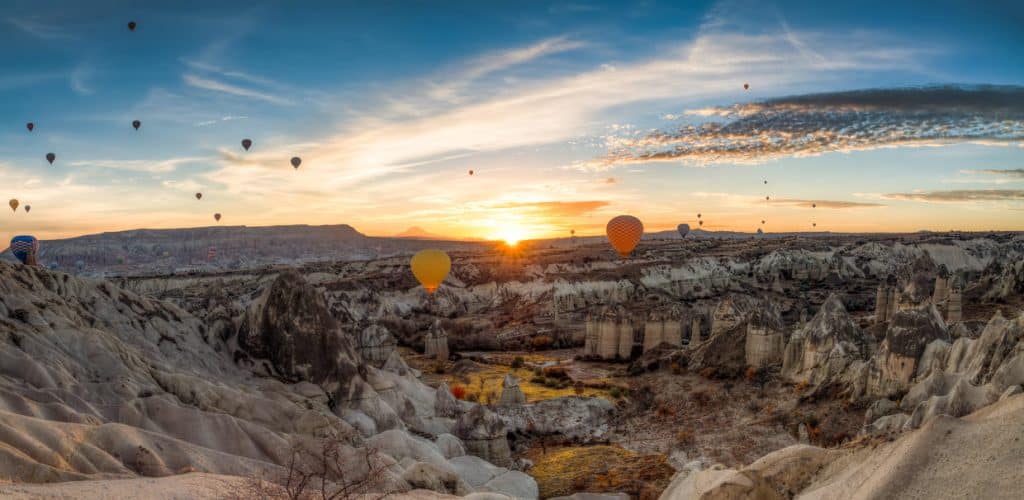
DRO:
This stands for Dynamic range optimize and analyses the contrast of your scene in real-time. It produces an image with optimal brightness and recovered shadow detail. You can use this function even while the subject is moving or during the continuous shooting.
- D-Range Optimizer: Auto (default setting): Corrects the brightness automatically.
- D-Range Optimizer: Lv1 ― D-Range Optimizer: Lv5: Optimizes the gradation of a recorded image for each divided area. Select the optimization level from Lv1 (weak) to Lv5 (strong)
Auto HDR:
(not available for RAW captures) this feature Shoots three images with different exposures and then overlays the bright area of the underexposed image and the dark area of the over exposed image to create a picture with an extended range from highlight to shadow.
The highlight detail in auto HDR is better than that in DRO and with reduced noise. The shutter is released three times, so using this function for moving subjects is not recommended.
- Auto HDR: Exposure Diff. Auto (default setting): Corrects the exposure difference automatically. Auto HDR: Exposure Diff. 1.0EV ―
- Auto HDR: Exposure Diff. 6.0EV: Sets the exposure difference, based on the contrast of the subject. Select the optimal level between 1.0 EV (weak) and 6.0 EV (strong). For example, if you set the exposure value to 2.0 EV, three images will be composed of the following exposure levels; −1.0 EV, optimal exposure, and +1.0 EV
Creative Style
This menu setting allows you to select the desired image processing. You can adjust exposure (shutter speed and aperture) as you like with [Creative Style], unlike with [Scene Selection] where the product adjusts the exposure.
- Standard (default setting): For shooting various scenes with rich gradation and beautiful colors.
- Vivid: The saturation and contrast are heightened for shooting striking images of colorful scenes and subjects such as flowers, spring greenery, blue sky, or ocean views.
- Portrait: For shooting the skin color in a soft tone, ideally suited for shooting portraits.
- Landscape: The saturation, contrast, and sharpness are heightened for shooting vivid and crisp scenery. Distant landscapes also stand out more.
- Sunset: For shooting the beautiful red of the setting sun.
- Black & White: For shooting images in black and white monotone.
- Sepia: For shooting images in sepia monotone.
Contrast, Saturation, and Sharpness can be adjusted for each Creative Style item. Select an item to be set by pressing the right/left side of the control wheel, then set the value using the top/bottom side of the control wheel.
- Contrast: The higher the value selected, the more the difference of light and shadow is accentuated, and the bigger the effect on the image.
- Saturation: The higher the value selected, the more vivid the color. When a lower value is selected, the color of the image is restrained and subdued.
- Sharpness: Adjusts the sharpness. The higher the value selected, the more the contours are accentuated, and the lower the value selected, the more the contours are softened.
Picture Effect
Think of this menu as an Instagram app right in your camera, with all kinds of retro filters and effects. These are only available when quality is set to Jpeg (Not in RAW).
- Off (default setting): Disables the Picture Effect function.
- Toy Camera: Creates a soft image with shaded corners and reduced sharpness.
- Pop Color: Creates a vivid look by emphasizing color tones.
- Posterization: Creates a high contrast, abstract look by heavily emphasizing primary colors, or in black and white.
- Retro Photo: Creates the look of an aged photo with sepia color tones and faded contrast.
- Soft High-key: Creates an image with the indicated atmosphere: bright, transparent, ethereal, tender, soft.
- Partial Color: Creates an image which retains a specific color, but converts others to black and white.
- High Contrast Mono.: Creates a high-contrast image in black and white.
- Soft Focus: Creates an image filled with a soft lighting effect.
- HDR Painting: Creates the look of a painting, enhancing the colors and details.
- Rich-tone Mono.: Creates an image in black and white with rich gradation and reproduction of details.
- Miniature: Creates an image which enhances the subject vividly, with the background defocused considerably. This effect may often be found in pictures of miniature models.
- Watercolor: Creates an image with ink bleed and blurring effects as if painted using watercolors.
- Illustration: Creates an illustration-like image by emphasizing the outlines.
(MENU → Camera Settings → page 6)
Focus Magnifier
When focussing manually or in DMF mode, you can set the camera to magnify a part of the screen so you can check focus. This sub-menu allows you to select the part of the image that will be magnified during shooting.
High ISO NR
Here you can select the amount of noise reduction applied to images with high ISO settings (when quality is set to jpeg). As Sony has rather aggressive noise reduction, I would chance it to Low. (if not, you run the risk of getting paint-like, smeared images at higher ISO values)
Lock-on AF
This is a very powerful autofocus feature. When turned ON, it allows you to track a subject. In the iAuto mode, you can access this feature (when turned ON and the camera is set to AF) by pressing the Center button of the multi-controller. You’ll see a square on your screen, then center your desired tracking subject and the camera will continue to track it, even when it exits your frame and reappears.
Smile/Face Detect
This is another powerful feature. It can be set to automatically detect on focus on (registered) faces and enable a function called Smile Shutter. When the latter is enabled, the camera will automatically capture an image when a smile is detected. Did I hear you say Selfie? Yes, it’s the ultimate selfie tool, along with the pivoting screen.
(MENU → Camera Settings → page 7)
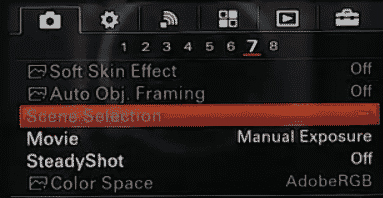
Soft Skin Effect
If you’re using this camera mainly for pics of friends and family, this is an excellent feature, as it will soften and smooth skin tones make you and your beloved ones look their best. (only available when quality is set to Jpeg)
Auto Object Framing
When enabled, the Sony A5100 will automatically crop your captured image to what it deems best. Meaning it will cut the picture for a nicer composition. Only available for Jpegs, though, a nice feature if you don’t want to bother too much with the technical side of photography.
Scene Selection
This is more easily controlled via the right thumb wheel when you’re in SCN mode, but you can also select the presets for different scenes (like sports or portrait) from here.
Movie
The ILCE-5100 has a dedicated movie shooting mode. In this mode (accessed via the mode dial) you can either select Program, Aperture, Shutter speed priority or full manual mode. These methods offer the same functionality as the modes on the mode dial (see explanation further down) only in movie mode.
Steady Shot
You can turn the lens image stabilization ON or OFF here. Should be OFF for taking time-lapses with the app for example.
Color Space
You can choose between Standard and Adobe (extended color range)RGB. If you don’t know what this means, leave it to standard.
(MENU → Camera Settings → page 7)
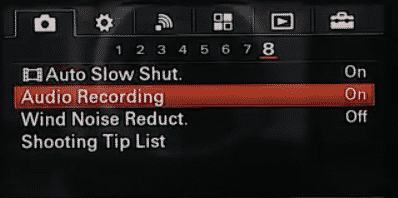
Auto Slow Shutter (movie mode)
Sets whether to adjust the shutter speed automatically during video recording in case if the subject is dark/ Set to ON.
Audio Recording
You can switch off audio recording in movie mode.
Wind Noise Reduction
This helps reduce noise from the wind during video recording. ON
Shooting Tip list
View all shooting advice on screen when you use the A5100
(MENU → Custom settings (wheel) → page 1)
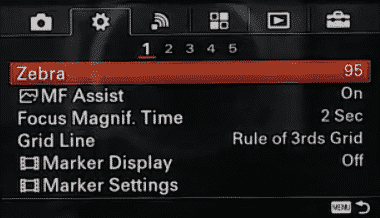
Zebra
The zebra function shows a zebra pattern on the screen while shooting in any area that is in danger of highlight clipping. You can switch this OFF or anywhere in a range between 70 and 100.The Zebra Pattern is a highlight warning indicator that is common in video cameras. It does not control exposure but just warns you that your highlights are blown out. It is not recorded into the resulting image.I have it set halfway at around 75, and it is a very useful indication of correct exposure of the full picture. As I capture in RAW, I am very careful not to have any highlight clipping, to be able to recover highlights in Lightroom possibly entirely.
MF assist
This works in conjunction with the Focus Magnifier on Page 5 of the camera settings. You might remember that you can select the area to magnify there when using manual focus (MF). MF assist will need to be turned on if you want to use this feature.
Focus Magnif Time
You can set how long to hold the magnified area during MF assist. 2 sec, 5 seconds or no limit. 2 seconds is how I have it set up.
Grid Line
Having a grid line on your screen is a helpful aide for the composition of your image.
The human brain is hard-wired to recognize the structure, and most people find a well-composed image more eye-pleasing.
During photography history, rules have been developed on how to compose the different elements best within a scene. Many landscapes you’ll see have the horizon run through the middle of the image for instance, but this is just composition in its simplest form. Many photographers with a thorough understanding of these techniques go far beyond that.
A good starting point is using the in-camera grid to make your brain aware of the possibilities in composition.
The Rules of 3rds, Square and Diag +square are available in the Sony Alpha ILCE-5100
Marker Display
Sets whether or not to display markers to enable alignment to a structure while shooting movies.
Marker settings
Sets the markers to be displayed while shooting movies.
- Center: Sets whether or not to display the center marker in the center of the shooting screen.
- Off (default setting) / On Aspect: Sets the aspect marker display. Off (default setting) / 4:3 / 13:9 / 14:9 / 15:9 / 1.66:1 / 1.85:1 / 2.35:1
- Safety Zone: Sets the safety zone display. This becomes the standard range that can be received by a general household TV. Off (default setting) / 80% / 90%
- Guideframe: Sets whether or not to display the guide frame. You can verify whether the subject is level or perpendicular to the ground. Off (default setting) / On
MENU – Custom Settings – page 2
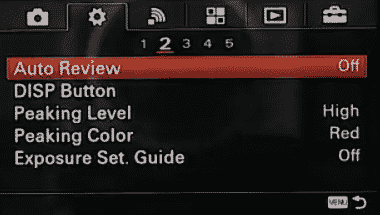
Auto Review
Select the amount of time the camera displays your image directly after capturing the image. 10, 5 and 2 sec is available, or you can turn this feature OFF if it annoys you.
Disp button
Selects the functionality (what is shown) on the screen when you press the DISP button (on the control wheel). You can choose Graphic Display, all info; no dips info and histogram.
Peaking Level
- Peaking Level is a manual focusing aide that works when you have your camera set to MF or DMF.
- You’ll see a type of noise outlining the parts of your image where the focus lies; you can adjust the sensitivity to high, mid or low.
- Which setting is best depends on what lens you use, as with a sharper lens it can be configured to low, while more soft lenses benefit from a medium or high setting to clearly visualize what you’re focusing on.
Peaking Color
You can choose the color of this Peaking between Red, white and yellow. I have it set to red, as this contrasts nicely with most scenes you capture.
Exposure set guide
Sets the guide displayed when exposure settings are changed in the shooting screen. Excellent tool when you’re getting to know the functionality of your new camera. If you’re familiar with Sony’s feature, turn it OFF.
MENU – Custom Settings – page 3
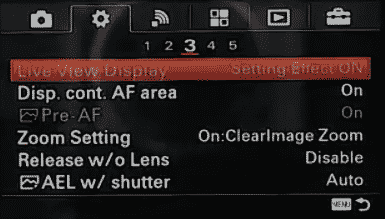
Live view Display
Live view display allows you to see the image you’re going to capture with the settings you have dialed in like aperture and shutter speed. Some users report easier auto-focussing in low-light when it’s turned OFF, and you’d need to turn it off when using external flashes too that can’t be used with Sony’s TTL (through the lens) functionality.
Disp cont AF Area
You can set whether or not to display the focus area that is in focus when[Focus Area] is set to Wide or Zone and Focus Mode is set to Continuous AF.
Pre AF
When pre-AF is set to ON, the camera will continuously focus, even without half-pressing the shutter button. This can be draining to the battery, especially when using some lenses like the Zeiss Touit range. Set it to OFF.
Zoom settings
Set to Optical zoom only (using the optical zoom capabilities of your lens
Two other settings are available which use digital zoom (cropping of the original image):
Digital zoom:
Pictures captured by the image sensor of the camera are enlarged using digital signal processing. As the magnification level increases, signals to be also estimated increase and can reduce the picture quality.
Clear Image Zoom:
Zoomed images are captured close to the original quality when shooting a still picture. The camera first zooms to the maximum optical magnification, then uses Clear Image Zoom technology to enlarge the image an additional 2x, producing clear, sharp images despite the increased zoom ratio. If you don’t have a zoom lens, this might be an option, as the camera uses the RAW file to zoom; although still some image quality will be lost.
Release without lens
Makes it possible to capture images even if a lens is not supported by the camera. (Like when using an adapter with vintage lenses)
AEL with shutter
Selects whether to fix exposure automatically when you press the shutter button halfway down. Leave ON.
- Auto (default setting): Fixes the exposure after adjusting the focus automatically when you press the shutter button halfway down when [Focus Mode] is set to [Single-shot AF]. When [Focus Mode] is set to [Automatic AF], and the product determines that the subject is moving, or you shoot burst images, the fixed exposure is canceled.
- On: Fixes the exposure when you press the shutter button halfway down.
- Off: Does not fix the exposure when you press the shutter button halfway down. Use this mode when you want to adjust focus and exposure separately.
MENU – Custom Settings – page 4
Touch shoot set
The camera automatically focuses on the point you touch the screen and takes a still picture.
- Touch the icon on the monitor while the shooting screen is displayed. The mark to the left of the icon turns orange. To cancel [Touch Shutter], touch the icon again.
- Touch the subject to focus on. When the subject you touched is in focus, a still image is recorded.
Self-portrait timer
You can change the angle of the LCD screen and shoot images while monitoring the image on the screen.
- Tilt the LCD screen 180° upward, and then point the lens at yourself.
- Press the shutter button. The product starts the self-timer shooting after three seconds. Hint If you want to use another Drive Mode than the 3-second self-timer mode, first set [Selfportrait/ -timer] to [Off], then tilt the monitor upward approx. 180 degrees.
- Hint If you want to use another Drive Mode than the 3-second self-timer mode, first set Self-portrait/ -timer to Off, then tilt the monitor upward approx. 180 degrees.
S Auto Img Extract
When in Superior Auto, the camera often takes multiple images and combines them into one (jpeg only). You can either save all images captured (OFF) or only the combined image (ON). Turn it OFF, I’ve tried this functionality, and the combined image feature does not work well.
Exp com set
Selects if the Exposure compensation functionality (+-5 in 0.5EV or 0.3EV steps) also reduces flash power or not. Leave it to Ambient And Flash.
Face Registration
This is where you can register faces; it works only when face recognition is set to ON (registered faces). This is an interesting functionality, as you can register faces of your subject (like at a wedding the bride and groom) and the camera will automatically detect these registered faces and give autofocus priority to them. You can register up to 8 faces (by taking a picture of them within this menu) and set a priority order.
Works well, and helps to get the right people in-focus in busy shots.
AF micro adjustment
This is only necessary when using a Sony adapter (like the LAEA4) with supported A-mount lenses. These lenses can auto-focus slightly off, and some micro adjustment can help getting the focus just right.
MENU – Custom Settings – page 5
Lens Comp
Lens compensation corrects certain lens issues like shading, chromatic aberrations, and distortion. If you shoot jpeg, it’s advisable to set them all to auto (works only with supported lenses), in RAW, turn them all OFF as you’ll probably want to take care of these lens related problems using a RAW editor on your desktop or laptop.
Custom keys setting
Assigning functions to the various keys allows you to speed up operations by pressing the appropriate key when the shooting information screen is displayed.
Movie button
Sets whether or not to activate the MOVIE button.
- Always (default setting): Starts movie recording when you press the MOVIE button in any mode.
- Movie Mode Only: Starts movie recording when you press the MOVIE button only if the shooting mode is set to Movie mode.
MENU – Wireless functionality – page 1
Send To Smartphone
- You can send one or several images directly to your wireless device (phone or tablet) by pressing this button.
- You can either decide to choose which images you want to transfer on the camera or on the wireless device (via the Sony PlayMemories app, available for free in the apple or android store).
- You’ll have to connect the camera via Wifi first (it makes a Wifi access point), using the instruction on the A5100 screen.
- It works just like connecting to any other access point with your phone or tablet.
- You should do this as quickly as possible, just to get it out of the way.
- When your phone has wirelessly connected to the camera once, and you’ve entered the password, it will remember this, and make it a lot faster to connect later.
Send to Computer
You’ll need to physically connect the computer to the camera using the supplied USB cable, and you can push selected pictures to your Sony PlayMemories desktop software (installed from the CD or downloaded from their website). This can even be set up to continue pushing images after the camera has turned off.
View On TV
If you have a Wifi-enabled TV, you can view images and slideshows directly from your camera through your home wireless network.
One Touch NFC
Enables Quick, one-touch connection (as opposed to first accessing the camera’s wireless network and then navigating to the Playmemories app) with NFC (near-field communication) capable devices.
I have not tried this (as my iPhone does not have NFC) but it looks a lot easier to use.
Airplane Mode
Disables all wireless functionality, just like airplane mode does on your phone.
WPS Push
If your access point has the WPS button, you can register the access point to the camera easily by pushing the WPS button.
MENU – Wireless functionality – page 2
Access Point Set
Here you can setup an access point for your camera to the internet.
It enables the Sony ILCE-5100 to install PlayMemories apps from the internet directly. Works just like setting an access point (WiFi connection) on your phone.
Edit Device name
If you wish, you can change the name of the Device Access point) perhaps to make it easier to identify which A6000 is yours in certain situations.
Disp MAC address
You can see the MAC address of the camera here, might be useful for some advanced configuration or troubleshooting
SSID, password reset
Reset the name and password of the wireless network the camera creates.
Reset Network set
Resets all network settings.
If something does not function properly, and you want to start from scratch, can be useful.
MENU – PlayMemories settings – page 1
Application List
You’ll find The Smart remote control camera app (wich allows you to use your phone as a remote control via PlayMemories phone app for iPhone and Android) and the Playmemories Camera app here.
You can access your online PlayMemories account here, or create an account (once you’ve set up your camera connection with your Wifi network).
You’ll also be able to download new apps available for purchase in the Sony Playmemories online app store like the Time-lapse and smooth reflection app.
If you do not want to connect your camera to the internet, you can always install new apps (and updates) if you connect the camera to your Mac or PC with the supplied USB cable, using the Sony PlayMemories desktop application.
MENU – playback options – page 1
Delete
Delete on or multiple images stored on your SD card.
View Mode
select how the camera will arrange captured images in the viewing browser.
Image Index
Select whether you want the image browser to display 12 (larger) or 30 (smaller) images per page.
Display rotation
Select whether you want the camera to automatically rotate images when you rotate the camera or not.
Slide Show
Select whether you want the camera to repeat slideshows when all pictures are viewed or not, and choose the interval between slides.
Rotate
Change the orientation of images in-camera.
MENU – playback options – page 2
Enlarge
Select an image and enlarge a portion of that image. Useful for checking details and focus.
4K Still Image PB
Outputs still images in 4K resolution to an HDMI-connected TV that supports 4K.
Protect
Protect images (selectable or per date) from accidentally being erased
Specify Printing
Specify Printing is a feature that allows images to be marked for printing later. Registered images are displayed with the DPOF mark. (DPOF stands for Digital Print Order Format)
MENU – Setup – page 1
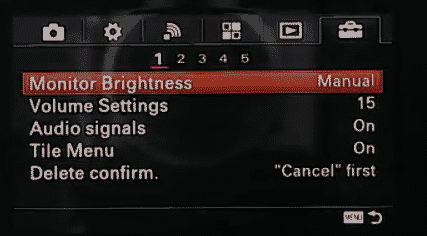
Monitor Brightness
Manually set the Monitor brightness (recommended leave to zero) or change to a brighter setting for Sunny Weather.
Monitor Brightness
Set to Auto which adapts to the lighting circumstances or manually changes to your preferred setting. There are a color and greyscale chart displayed on the screen to allow you to set it up to your liking.
Volume settings
Change the playback volume for recorded video or demos.
Audio Signals
You can turn off audio signals like the bleep when te camera achieves focus. Useful if you want a more stealthy operation (although you’ll still hear the second curtain shutter).
Title Menu
choose between tiles or a tiled front page when accessing the MENU or a direct tab style menu layout.
Delete Confirm
When deleting images on your SD card, you’ll have to confirm every deletion (to make sure you don’t accidentally delete anything). You can turn Off this confirmation here if you wish.
MENU – Setup – page 2
Pwr Save Start time
Selects the time it takes for the camera to go into sleep mode if you don’t use it.
PAL/NTSC mode
change to either of this broadcasting standards according to which region of the world you live in
Remote CTRl
When the Sony A5100 is connected via USB to a PC, you can use the Remote Camera Control (RCC) software to take pictures or change settings on the camera from the computer. ( Both Mac and PC versions downloadable via the Sony website). If you would like to do so, you’ll need to turn this ON here. There is now a special version of Capture One available (free) for Sony cameras which also has this functionality.
HDMI Resolution
Set the Resolution of images and video sent to your TV with an HDMI cable (1080p or 1080i)
CTRL for HDMI
With the “Control for HDMI” function, Sony BRAVIA Sync helps communicate with BRAVIA Sync-compatible equipment using HDMI CEC.
MENU – Setup – page 3
HDMI Info display
Another function for viewing images and video on a TV through HDMI connection. Select whether to display the shooting information when this product and the TV are connected using an HDMI cable.
MENU – Setup – page 4
USB connection
Selects what will happen when you connect your camera to your PC or MAC.
USB LUN Setting
Improves compatibility with external devices by limiting the functions of the USB connection.
Older devices that are not able to connect to the camera might work when set to single. Otherwise, use Multi.
Language
Set your preferred language. The advantage of setting it to Eglish is that you’ll find much more information online when you need any troubleshooting.
Date Time Setup
Change date, time, date format and Daylight savings time
Area setting
Select your region, or change region when abroad, the camera will automatically change time and date for you.
MENU – Setup – page 5
Format
Format your SD card before use; this will erase any images still on the memory card.
File Number
Number your files according to number of shots or reset it to start from 1
Select REC folder
Selects where the camera will store newly captured images
New Folder
Make a new folder for easily organizing events and locations
Folder name
Choose whether to have folder names in standard form (DSC) or create a new one by date. Setting folders by date will make organizing your images easier.
Recover Image DB
If you have a storage card error, you can try to rebuild the database to possibly retrieve lost images.
MENU – Setup – page 6
Display media info
You can check how much space is left on your SD card (have pictures in your desired quality and how many minutes of video)
Version
Check what version of the operating system your camera and lens are running. Sony sporadically releases updates with new features, so it might be worth checking if any new firmware versions are available.
Setting Reset
Fully resets the camera to factory settings.
The Next Chapter is about the different shooting Modes Available, another concept that is necessary to understand fully.
shooting modes available via the Select button on the back of the camera ( or via MENU → Camera Settings → Shoot Mode→ desired setting)
Intelligent Auto:
This mode automatically detects the type of scene you’re shooting and adjusts the scene automatically. You’ll see the icon for the recognized scene appear on the top right hand of the screen.
These scenes are the same ones which can be selected individually in SCENE mode.
The Sony A5100 will also use the most appropriate FOCUS AREA, and ISO value (the ISO range cannot be changed in iAuto though).
Drive Mode (single shooting, continuous shooting Lo-Mid-Hi), Self-timer and Self-timer cont (multiple images with the self-timer) can be changed by using the Fn button.
Works for both RAW and JPEG shooting.
Disadvantage: ISO range is fixed to 50-6400 (you can’t change the range).
Superior Auto:
Superior Auto is similar to iAuto, as it also detects scenes automatically, except it uses more complex processing.
This includes composite layering (layering different shots on top of each other for HDR style pictures) and automatically choosing what it thinks is the best image.

You can either choose whether you want the camera to save all images captured or just the composite image, by selecting S. Auto Img. Extract in the MENU system.
Disadvantage: ISO range is (like in iAuto) fixed and only useable for jpeg shooting.
P (Program Auto):
Program (P) mode automatically adjusts exposure and aperture according to your desired setting.
See this as a more advanced iAuto mode, as you’ll be able to change all other settings through the touch screen (Focus area, creative style, exposure compensation,…);
tip: lower the automatic ISO range to 100-1600 for better image quality (ISO-Auto range in MENU SYSTEM)
A (Aperture Priority):
Allows you to adjust the aperture and shoot, for example when you want to blur the background (large aperture like f/1.8), or want a sharp corner-to-corner image (around f/5.6-f/8).
The aperture value can be changed during movie recording, a technique that will be familiar to videographers.
Smaller F-value: The subject is in focus, but objects in front of and beyond the subject are blurred (what is called Bokeh).
Larger F-value: The subject and its foreground and background are all in focus.
If proper exposure cannot be set, the shutter speed on the shooting screen blinks.
S (Shutter Priority):
The go-to mode if you cant to shoot fast-moving subjects, by manually adjusting the shutter speed. You can express the movement of a moving subject in various ways by adjusting the shutter speed, for example, at the instant of the movement with a high-speed shutter, or as a trailing image with a low-speed shutter. The shutter speed can be changed while recording movies. The aperture is automatically adjusted to obtain proper exposure.
If proper exposure cannot be obtained, the aperture value on the shooting screen blinks.
- Use a tripod to prevent blurring when you use a slow shutter speed.
- The SteadyShot warning indicator does not appear in shutter speed priority mode.
- When the shutter speed is 1 second(s) or longer, noise reduction will be applied (Long Exposure noise reduction in the Menu ON/OFF) after shooting for the same amount of time that the shutter was open. This will temporarily freeze your camera, and you want to be able to capture images while noise reduction is in progress.
- The brightness of the image on the monitor may differ from the actual image being shot (there is no Live view on Sony cameras for long exposures).
M (Manual Exposure):
Both shutter speed and the aperture value can be changed in this mode, also during movie recording.
Press the bottom side of the control wheel to select the shutter speed or aperture value, then turn the control wheel to select a value.
When ISO Auto is used, the ISO value automatically changes to achieve the appropriate exposure using the aperture value and shutter speed you have set.
- If the aperture value and shutter speed you have set are not suitable for appropriate exposure, the ISO value indicator will blink.
- When the amount of ambient light exceeds the metering range of the Metered Manual, the Metered Manual indicator flashes.
- The SteadyShot warning indicator does not appear in manual exposure mode.
- The brightness of the image on the monitor may differ from the actual image being shot.
Bulb Mode in Manual exposure
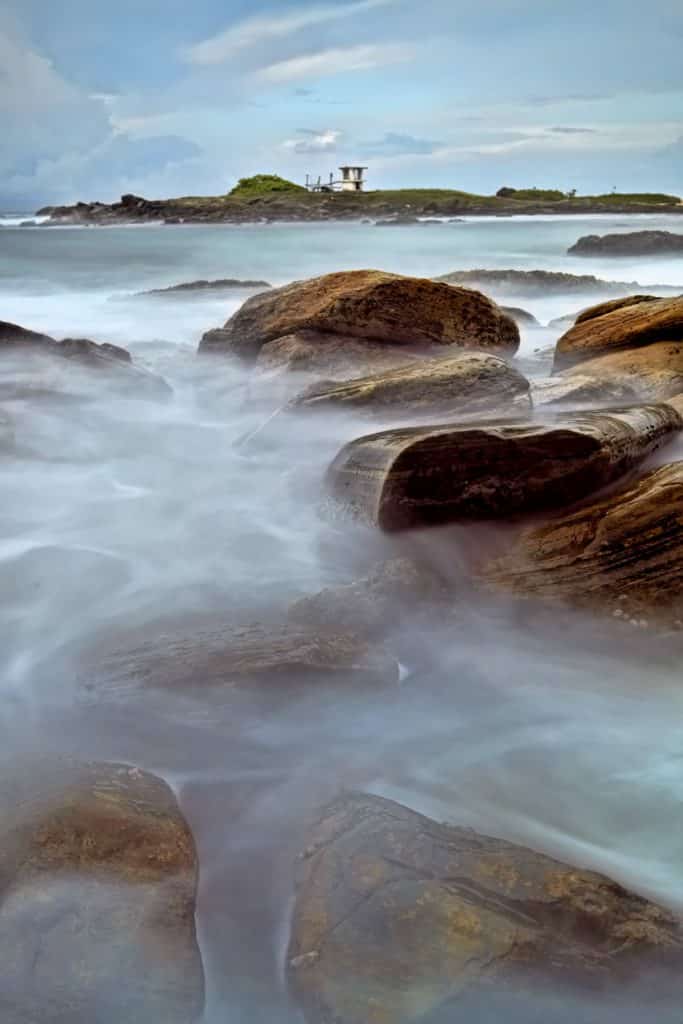
Bulb is the mode used to shoot a trailing image of a subjects’ movement with a long exposure time. Think light trails from cars or fireworks.
- Press the bottom side of the control wheel to select the shutter speed, then turn the control wheel counterclockwise until BULB is indicated.
- Press the shutter button halfway down to adjust the focus.
- Press and hold the shutter button for the duration of the shooting.
- As long as the shutter button is pressed, the shutter remains open.
Tips:
- Use a tripod for long exposures.
- Use the PlayMemories remote or a wired remote control to eliminate any movement of the camera.
- After shooting, noise reduction will be applied (as noise builds up quickly with long exposures). This will take as long as your long exposure did, and you won’t be able to use the camera until this is finished.
Can’t get the shutter speed to Bulb Mode? Check these settings and turn them OFF:
- Is Smile Shutter activated?
- Is Auto HDR activated?
- Is Picture Effect is set to HDR Painting or Rich-tone Mono?
- Is Drive Mode set to Cont. Shooting, Cont. Bracket or Self-timer(Cont)?
Movie:
Although you can capture movies in any mode, it is easiest to change all related settings for movie recording here. You can adjust the shutter speed or aperture value to your desired settings for recording movies. You can also check the image angle before shooting.
Press the MOVIE button to start recording and again to stop recording
Menu:
- Program Auto: Allows you to shoot with the exposure (both the shutter speed and the aperture value) adjusted automatically. Other settings can be adjusted manually, and the settings are retained.
- Aperture Priority: Allows you to shoot after adjusting the aperture value manually.
- Shutter Priority: Allows you to shoot after adjusting the shutter speed manually.
- Manual Exposure: Allows you to shoot after adjusting the exposure (both the shutter speed and the aperture value) manually.
When a zoom lens is mounted, you can also zoom by operating that lens. When a motor zoom lens is mounted, move the zoom lever of the zoom lens to enlarge subjects.
Sweep Panorama:
Allows you to shoot a panoramic image by compositing the images.
- Panorama mode will capture a series of images in succession.
- You’ll be guided through this process using an arrow on-screen that shows the direction and speed of the camera panning.
- The A5100 will automatically detect and capture the series of images while panning.
- Afterward, it will stitch together all these images into a wide view of the scenery and save it as a Jpeg.
TIP: Panorama size (standard or wide) and panning direction can be changed in the MENU on page 1.
Scene Selection Mode (SCN)
Allows you to shoot with preset settings according to the scene. iAuto and Superior Auto detect these scenes automatically for you and applies the presets it deems best and does a very good job at that. However, in certain circumstances (when you know what you are going to capture) it is better to select the appropriate scene yourself, as it takes the guessing work out of the equation.
The Sony A5100 has a descent range of well-designed presets:
Portrait:
Blurs background for a nice Bokeh, and sharpens the subject. How good this will look depends largely on the lens you’re using. A zoom is less suited to this kind of photography, best use a prime, fast lens.
This preset accentuates the skin tones softly (you can select skin softening for all Modes in the Menu system too).
Sports Action:
Shoots a moving subject at a fast shutter speed (lso that the subject looks as if it is standing still. AF-C and continuous shooting hi is on, so you’ll be able to snap away while the shutter button is pressed.
Macro:
Shoots close-ups of the subjects, such as flowers, insects, food, or small items.
Landscape:
Shoots the entire range of scenery in sharp focus with vivid colors. The camera will go to a smaller aperture to achieve this, as lenses are sharper corner-to-corner at smaller apertures.
Sunset:
Shoots the red of the sunset beautifully.
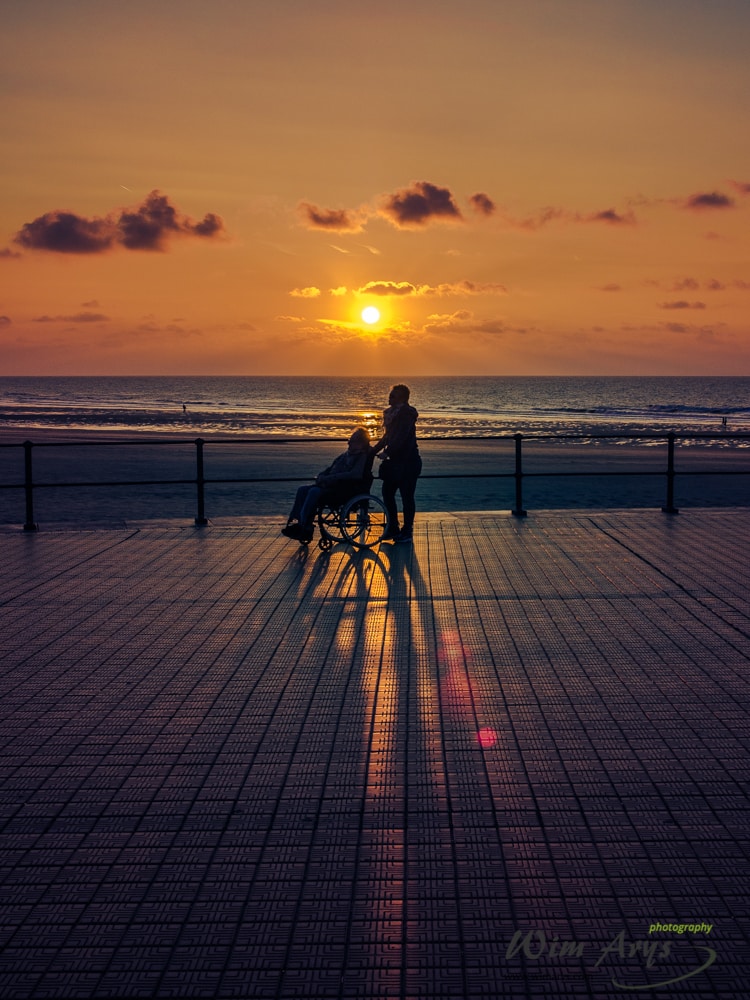
Night Scene:
Shoots night scenes without losing the dark atmosphere. Will go to higher ISO values and larger apertures to achieve a useable shutter speed, enabling you to capture sharp images without blur. The A5100 does have its limitations when it comes to shooting dark scenery.
Hand-held Twilight:
Shoots night scenes with less noise and blur without using a tripod. A burst of shots are taken, and image processing is applied to reduce subject blur, camera shake, and noise. This does not work well in my opinion.
Night Portrait:
Shoots night scene portraits using the built-in flash.
Anti Motion Blur:
Shutter Priority mode, which will use the fastest shutter speed possible, to counter motion blur.
Best A5100 for shooting portraits and make-up
Shooting portraits and makeup is a challenge for many photographers. Firstly we need to think about what we want to achieve. Do you want a blurred background? Then you’ll need a lens with a large aperture like the Sigma 60mm f2.8 DN or the Sony Sonnar T * FE 55mm F1.8 ZA. As a rule of thumb, the larger your aperture (the f number), the more separation between subject (focus point) and background you’ll have. If you’re going for maximum sharpness and detail, you can stop down the lens (change aperture) to around f/8.
Shooting at smaller apertures means that your lens will allow less light to enter the sensor, and a flash might be a good investment. I recommend a brand called Godox (or flashpoint/Neewer these are all the same brands) and also a ring flash diffuser to get a soft and even illumination of the face.
To get real looking colors, It’s a good idea to set your creative style ((MENU → Camera Settings → page 5) to standard and find a suitable white balance (also on page 5). Try the ‘Fluor’ settings if you are shooting under fluorescent light.
Other things you can consider are shooting in RAW so you have more control over white
shooting in RAW so you have more control over white balance in Adobe Lightroom (or other RAW editors).
Buy a so-called gray card for even more precise colors using custom white balance in your camera.
Calibrate your monitor with something like Datacolour Spyder to make sure your monitor is displaying the colors as true as possible.
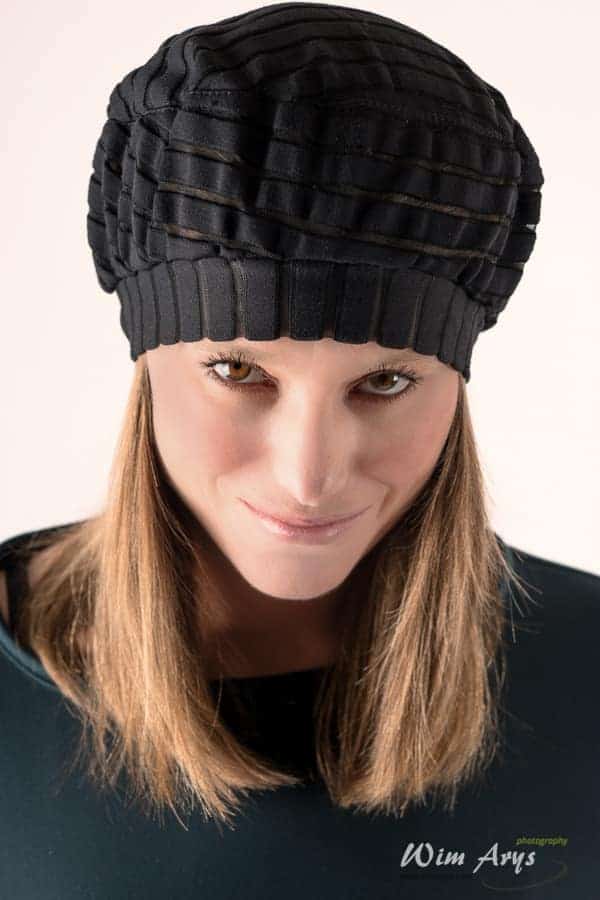
Conclusion
The Sony A5100 is certainly a very capable camera, and image quality rivals that of the A600 and A77II. At this price-point, that is almost unbelievable, and I’m sure many novice photographers will jump at the chance to get all this technology.
You’ll probably start using it in iAuto mode, and this is well-implemented, except for the fact that the ISO range cannot be changed. After you’ve familiarized yourself with this mode, it is well worth getting to know the advanced functionality of this camera, as it often will yield better results than just setting it to iAuto.
If you have any questions, feel free to comment below.
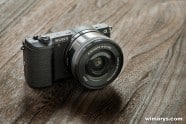
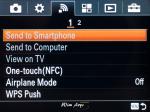
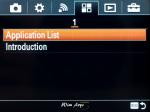
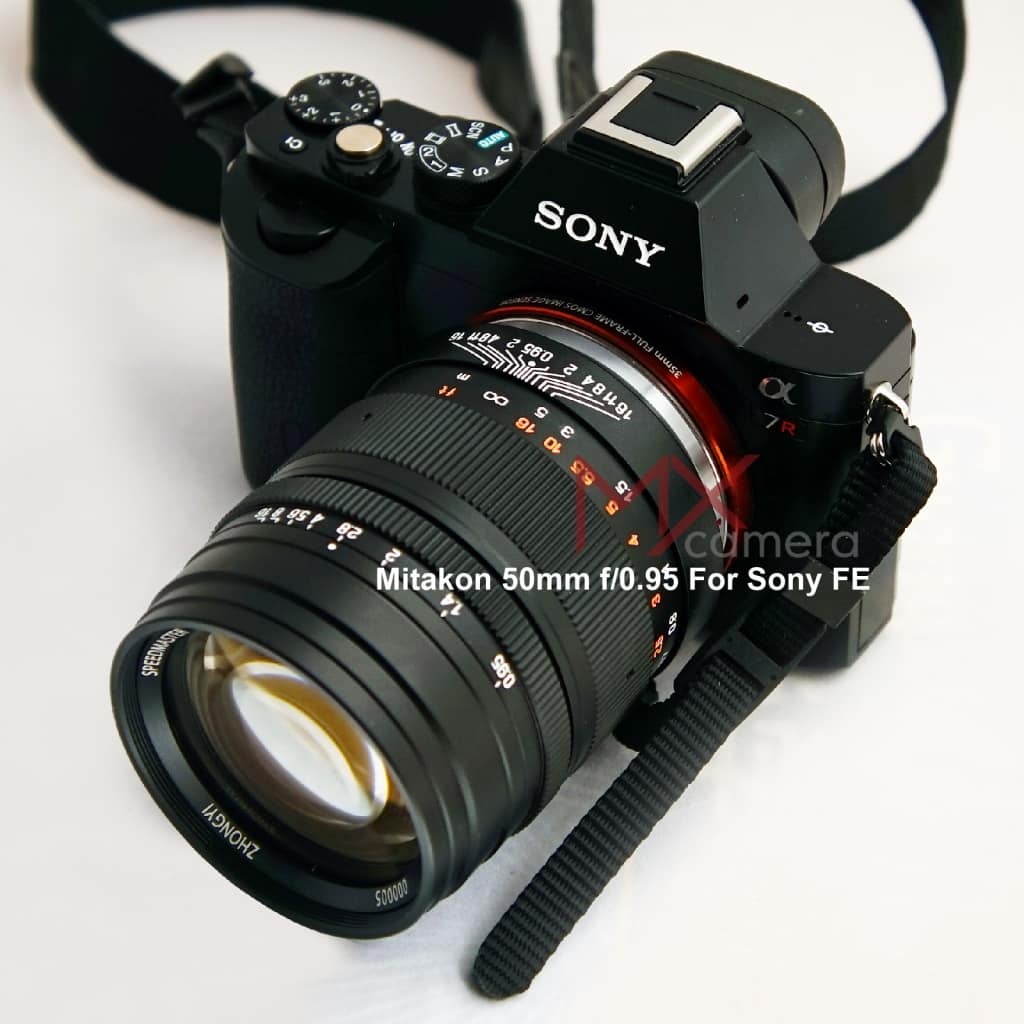
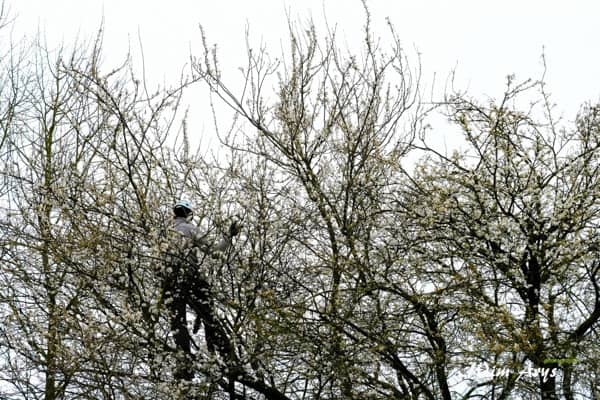
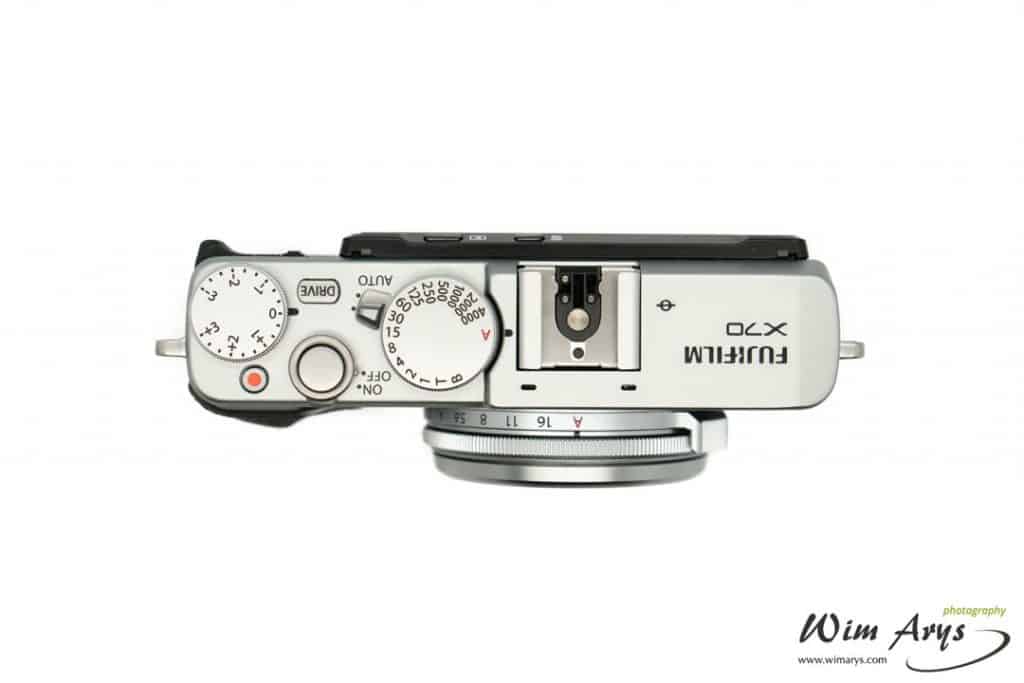

This is a great guide! Thanks!
Thanks Richie, I like your photography style, do you have a flickr?
I haven’t updated it in forever but everything I shoot is public https://www.facebook.com/richandcreamy/ The PMX folder I shot with my 5100. (I had no idea you replied to me till I came back here for more information! haha thanks!)
Hi Wim, Thanks for this guide, it is super helpful and much better than Sony’s own documentation. They should hire you! 😉
Hi Curtis, thanks, I really appreciate your comment!
Hi Wim,
I have a serious issue.
I bought the A5100 thinking it would be an upgrade from my Nex-3n, but it seems that the A5100 does NOT have a quick menu functionality, just like in the Nex-3 , Nex-5, A6000 and every freaking other sony camera basically.
I just want to confirm that this guide you wrote was in fact based on information that is accurate for the A6000 but that does NOT apply to the A5100 ? Or are you sure that the info in this guide is specifically accurate for the A5100 ?
The main issue is relating to this quote of yours:
MENU – custom Settings – page 6
On Page 6, you’ll find all customisable keys and functions of the Sony A5100 buttons and wheels. As this camera does not have a dedicated Fn (function) button, it might be a good idea to set this functionality to the HELP button (if you’re done using it). The Function Menu allows for quick access to the most used settings like ISO, focus area, flash functionality,…
Are you SURE that there is an option to set the help key to become the Fn button? I’ve looked again and again, and I find no way to do this.
This really sucks, the quick menu was extremely useful especially since there are so little button on the camera, it allowed me to use the Nex-3n pretty efficiently / quickly even without all the buttons… If I find it incredible that sony decided to remove this in the supposedly superior A5100, this is a HUGE deal, it literally makes the camera A LOT less user friendly to use…
I really hope that I am wrong.
Hi Rasta Cook, thanks for informing me about this. I know what you mean about the omission of a dedicated Q button, it’s a major pain and that’s why I thought of this little trick to bypass the problem. I actually write these tutorials with the camera in one hand and the manual in the other. I don’t own the A5100 anymore so I can’t re-check this for you unfortunately. But I’ll go over the manual again and see if I can dig it up, if not I’ll remove it from the post.
Is there anyway to do a factory reset if the camera is locked up ad there is no screen display?
Thanks for the excellent post.
Have you tried removing the battery for a day or so?
Yes, I did– but that didn’t do it. It turns out the trick is simply to redo the update. Even though the camera was bricked with a constant red light on the power indicator, the update recognized the camera and redid the update. One of two things happened– either it was this time using the right usb cable (the shorty that came with the camera– I wasn’t sure which of the two newer cables I had came with the camera) or the computer sleeping during the update. I didn’t sit and watch the whole thing, but when I came back to check the first time, the computer was asleep. I changed the preferences so it wouldn’t sleep as well. This time the update worked. So in this case, Sony’s software was smart enough to work through the problem. Thanks for responding– much appreciated.
Hi Brien, great that you got it sorted. And thanks for your detailed fix, I’m sure it will benefit others. Enjoy your camera!
Which update was this? Where did you download it from? Details please. My camera is doing the exact same thing. Also noticed that the shutter is closed.
Remember that you do need to use the supplied Sony USB cable. There are many different quality USB cables out there…
Hello Wim,
I bookmarked this website, and read through it 3x already. Thank you for a wonderful insight and information, I have a a6000 and loving it. Is it advisable to purchase the SEL35F18? or Sigma 30mm f2.8? or just stay with the original lens kit SELP1650?
Thank you and much appreciated with your input.
Beste Wim
Bedankt voor je uitleg. Heeft u dit ook in andere taal?
Alvast bedankt.
Dag Celik, al eens geprobeerd via google translate? Groeten, Wim
Hallo Wim, eerst en vooral gefeliciteerd met uw website. Ik heb net de a5100 gekocht en uw bevindingen hebben me al goed op weg geholpen. Vervelend is wel het “pompen” bij AF in movie-mode. Ik hoop dat dat effect verdwijnt met het aanpassen van de AF-snelheid. Of is er een andere oplossing? Ik ben bij momenten video-journalist, vandaar dat AF voor mij zeer belangrijk is.
mvg
Dag Peter, ik begrijp uw probleem. AF snelheid zou ik idd trager durven zetten, verder zie ik niet veel mogelijkheden. Sony geeft helaas minder aanpassingsmogelijkheden wat betreft AF in dit instapmodel, zeker voor video.
Hi there! This was so super helpful – thank you so much!!! I’m a bit of a novice, I have a lens question… Will the a5100 work with full frame lenses, eg SEL35F28Z? Thank you for your help!
Hi Jen, yes it will. It works with any E-mount lens, full frame and APS-C.
I recently bought a5100 and tried to using fujinon 55mm f1,8 with adapter m42 – nex, it fits well but I can’t take photo with it. any suggestion on what’s wrong with it? thanks a lot..
Hu Rezarioo, have you switched on ‘release without lens’ in the menu system?
Hello,
So, if I did understand correctly, there’s no “silent mode shutter” on the a5100.
Also, on my a5100, I’ve looked everywhere and there’s no “cleaning mode” option. How comes ?
Thanks,
V.
Hi Vincent, the A5100 has a front curtain electronic shutter, but the rear curtain is always mechanical. This means totally silent shooting is impossible. I don’t know why Sony decided to remove the cleaning mode on this model, probably a cost cutting measure.
Hi Wim, thanks for the guide. I gravitated towards the Sony a5100 because of its self portrait option. However I don’t think this is much help without a selfie stick. Could you please recommend a selfie stick i could use with my Sony a5100 or other DSLRs?
Hi Peachu, sorry, can’t help you there. Maybe you could use a wide angle though.
This is a great article for beginners. Thanks a lot!
Hi thank you for this article. I just bought this sony a5100 but I found some setting isn’t in the same page as you describe here. I mean like some setting that you describe is ini page 1, but in my camera it’s in page 2. Do you know why? And what can I do with kit lens? Can it make bokeh? And any tips to taking some good portrait photos? Thanks
Hi Tia, could you tell me what pages? thanks, Wim
Hi Wim! This has been extremely helpful for me getting familiar with my new camera! I had a quick question…there are times when I take a picture (usually indoors) and the picture will automatically adjust a little and give the image an orange tint. Is there a setting I can change to stop this? Thank you so much!
Ashley
Hi Ashley, that is due to auto white balance. You can change this in MENU → Camera Settings → White Balance.
I found that starting to film footage in Superior Auto (Rather than from Movie setting) produces outstanding footage compared to using Movie Mode. To the point I couldn’t understand what the problem was with Movie Mode. So if your footage is looking washed out or has artifacting use Superior Auto as the settting when you push the Movie button to start recording. The difference is significant.
Interesting, thanks for sharing! Best, Wim
Hi Wim, I am considering getting a zoom lens for my a5100 just so that I can get some photos of the local wildlife. what would you recommend? I know it won’t work on AF but I was thinking of getting a Vivitar 500mm as they are under £100
Hi Noctus, for under £100, why not give it a try? There are no other real cheap options for E-mount tele lenses I’m afraid. It’s not going to be ideal quality wise, and I’m guessing difficult to focus though.
Wow! I just breezed through this article briefly. What a wealth of info. Having just purchased the A5100 coming from a Canon SX700HS point and shoot, I was a bit overwhelmed. Thank you for taking the time to put this together. I know it will answer a lot of questions as I begin to get familiar with the camera. Thanks again Wym.
No problem Henry! Enjoy your A5100.
Very helpful!! I just received my camera today and this answered a ton of my questions. Thanks for writing!!
Happy to help Taya!
I have a sonya5100 camera and I can’t seem to figure out how to get my recorded videos to play on any computer, I think I might have accidentally done this but they seem to be showing up on the computer as a bdmv file and I’m not sure if that can be changed to a different format to play on media player or if I can download a different program besides media player that will play that type of file.
I am using a Microsoft surface pro 3 with windows 10
Any help would be greatly appreciated , thank you
Hi Shelby, perhaps it’s a setting on your surface pro, as BDMV files are used for Blueray disks. I think you changed something in the software of your computer.
hi Wim,
its a wonderful document. sony has to learn from you :).
Do you have custom settings for photographs. like portrait,nature,daylight ,night,.that would be more helpfull. thanks
peter
Hi Peter, thanks! I personally use aperture priority if I don’t like the iAuto settings. A fast aperture for portraits gives you separation between subject and background, use auto ISO for this. Landscapes are best shot at an aperture between f/5.6-f/8 at Low ISO. Night photography would be at the fastest aperture and change auto ISO to between 100-25600. Best, WIm
Great info! But do you have any suggestions on how to transfer a video in AVCHD format to android tablet?
I’m afraid not Leanne.
hi wim, thanks for making this site. i’ve been using this camera for product photography. i will admit i’m no camera expert, but this one has given me quite a few problems that i haven’t encountered with other cameras in this price range.
1. it has a hard time properly representing colors under lights and outside. as i am trying to represent colors accurately, this is deal breaker (i already bought the camera, so too late). it seems to really struggle with red, orange, and purple.
2. i am probably not stating this correctly, but it has a difficult time maintaining a read on the white balance, e.g., i can point it at a white space and it will often go from grey to white and back – but not in any regular way. it will also “get stuck” in a kind of sepia tone and not switch back. usually i will turn it off and when i come back to it later it won’t have the problem – until the next time.
3. no matter what focus mode i have it in it seems to not focus on the whole object.
i have tried using the camera in the two auto modes and the manual mode. either i know much less than i thought, or this is a dud, or..? i’m just about to sell this thing off to someone more knowledgeable because i’m pretty fed up at this point.
i was going to update the software, but it is a major hassle. sony does not make it easy at all. do you think it would help?
hope you have some ideas for me.
Thanks,
Jon
Hi Jon, sorry for the late reply.
It looks like many mirrorless cameras have difficulties with auto white balance and artificial light. I would recommend using a colorchecker passport if you are after a ‘true’ color rendering, it’s the only failsafe way of getting this.
I don’t know what lens you’re using, but it should help to switch to a smaller aperture, somewhere between f/5.6 and f/8. And use a single AF point if focus is critical.
Hope this helps, good luck! best, Wim
Guys I cant find the E-front curtain shutter,that the guide said.Is it possible that sony removed it?I dont like the sound of the shutter but i cant really do anything to change it and that really pisses me off.
Great guide! The Alpha 5000 has almost the same options. Thanks man!
You’re welcome Sergio!
I can’t view my photos on my sports action mode on my laptop or when i put them on something else like my hard drive they still come up as an icon not an image, it shows DSC and the number of the image can you help?
Hi Yardley, firstly are you shooting in JPEG or RAW?
I’m still learning this camera and I LOVE IT! This guide is VERY HELPFUL thank you ! Question : By accident I found a setting where the camera bursts 3 shots adjusting the lighting with each one and now I can’t find that setting again. I am a hairstylist and mostly take “after” pictures of my clients finished hair styles from the back or sides to showcase my work on social media. This setting was super helpful because lighting is everything when trying to capture tonality of hair. Where is this setting found? and perhaps you additional tips for me taking pics of my clients hair?
Hi Alexandra, thank you! You are looking for drive mode: cont. bracket. (MENU → CAMERA SETTINGS → PAGE 2)
I frequently use the ‘Camera Setting Reset’ or ‘Initialize’ option while learning this camera since I often get lost and have to start over. Since modern cameras are software driven small bugs also may appear especially at hard testing conditions that require a reset to uphold functionality.
The camera may have a slight tendency towards orange color, but that may serve as a trademark as well..
Thanks for your input G.
Excellent guidance for a lot of current Sony cameras, BUT there some glaring errors, e.g. reference to a viewfinder, curtain shutter, and the ability to customise the Help key as a Function key (I wish this were the case). Otherwise, this is the quick start guide that Sony should be including in the box.
Hi Sailesh, thanks for your comment. I thought I corrected most of these in the past, but apparently not. Well all up to date now. Enjoy your camera!
Hi With,
I have just got the Sony a5000 and was wondering how to set the self timer? So I can take a pictures without a camera man on the tripod
Hi Frank, you’ll need to go into the drive setting and scroll down to self timer.
I stopped reading after I couldn’t find the Wireless mode on flash function.
I hope you are aware it is not available on the A5100, or I hope I was wrong and just couldn’t find it.
It is available on the A6000 though.
Hi Illya, I would advise you to never stop reading. It would be a shame to give up the number one source of knowledge because you can’t find the wireless mode on an A5100.
I hope that you’ll get back to reading now that I’ve completely overhauled this advanced guide for the Sony A5100 to reflect the differences between the many versions of the latest Sony APS-C cameras.
Hi. Can you help suggesting what is the best way to focus and take a good picture in the dark using a5100? I just bought a 18-200mm Lens and was trying to take a photo, zoomed in to 200mm in a dark room with light coming in from the other room. It wouldn’t focus on the object. When it took the photo the picture of the bags was all blurry! 🙁 could you suggest what to do? My dslr produced a focussed picture but my a5100 did not! Can you also suggest how to take photos of the milky way with the a5100?
Thanks xxx
Hi Bernadette, at 200mm, you’re at f/6.3 so it is no surprise that you have problems focussing in the dark. try to find a faster f/2.8 zoom if you want to do this. Raising ISO could also help.
For Milky Way shots, use a tripod, focus manually using the focus magnification function and use the 2 seconds self-timer. It’s best to stay below 20 seconds exposure in order not to have too much movement of the stars, so choose an appropriate ISO value to achieve this.
Thanks so much for the guide I am still learning and it has helped a lot. Just have a few questions. I am currently shooting in manual mode AF-Single Shot with Focus area set to flexible spot M.
The issue is i cannot move my flexible spot focus point around the screen unless i go in to the menu or my customized focus area button and select flexible spot every time i want to take a photo which doesn’t seem right. When selecting this, it also takes away my gridlines. Not sure what i am doing wrong 🙁 is there anyway i can shoot in Manual mode, AF -S , keep my grid lines, and not have to choose flexible spot every time i want to take a photo to enable my flexible spot focus to work ?
Thanks
Hi Lisa,
have you tried pressing the down button on the wheel to access the flexible spot and select the placing of said flexible spot? It is possible that you’ll first need to customize that button to select the flexible spot in MENU – custom Settings – page 5.
Hi Wim,
my Sony a5100 has no “Menu – Custom Settings – (page) 6”.
“Custom Key Settings” is under “Custom Settings” – (page) “5”.
Lisa,
I customized the “Down Button” to “Focus Area”.
In manual mode “M” the button switches only between ‘Exposure Settings’.
In mode “S”, “A”, “P” it changes to “Focus Area”, “Flexible Spot: M” as expected. ‘Enter’ and you can move the ‘Flexible Spot’.
As you described the function.
I guess there is no ‘shortcut’.
Another guess: the grid disappears as the camera uses this ‘layer’ (?) to show the Flexible Spot.
Kind regards
Werner
Hi Werner, if you read through this guide, you’ll notice that this has also been changed in this post. Best, Wim
Hallo
Ik gebruik deze camera om video’s van mijzelf te maken voor YouTube. Ik heb 2 softboxes and een ringlamp voor mij staan. Om de een of andere manier als ik mijn video upload op mijn computer zit er een oranje gloed over mij heen.
Ik film in de modes: Film > P > En dan mijn ISO op 100 en Belichting Comp op 0.
Op mijn Canon kon ik altijd kiezen voor Daglicht, TL licht etc en dit verholp dan het probleem.. maar op deze camera kan ik het probleem maar niet vinden.. Hopelijk weet u wat ik kan doen.
met vriendelijke groet,
An
Hi An, deze al geprobeerd? To get real looking colors, It’s a good idea to set your creative style ((MENU → Camera Settings → page 5) to standard and find a suitable white balance (also on page 5). Try the ‘Fluor’ settings if you are shooting under fluorescent light.
My Camera did not come with a manual (I don’t know if any of them do anymore) but this is EVERYTHING that I’ve been searching the internet for…. your information is thorough, compact, and easy to follow. Thank you soooooo much!
Thanks Samantha!
Thank you. This is a great help. 😀
thanks for reading 🙂
My Sony alpha a5100 can snap picture as usual but Wonder why I cannot use all the buttons like timer, menu, etc.
Very good article. It helped me a lot, I am new with the A5100. Thank you.
Thanks Rodoza!
i have the Sony A5100 and all of a sudden it is stuck in Selfie mode and I cannot take pictures the regular way. I have never dropped it or any water damage. it is practically new. please let me know how to fix this problem if possible.
Hi Alyz,
Best would be to reset your camera and see if this solves your problem. Go to MENU – Setup – page 5 and do a “Settings Reset”. Let me know how you get on. Best, Wim
Hello,
When I try to send pictures to my iphone through the wifi on the Sony A1500 it doesn’t let me choose an image instead it says Wifi on standby and then says “No images.” Would you know how to solve this problem? Thanks!
Hi Gee, are you sure the camera is actually connected to your smartphone? You need to go into settings on your phone and connect to the WiFi network of your camera. Best, Wim
Thanks for the guide. My 5100 will arrive soon. I’ll have a short period to practice before shooting a video of something important, so I’d like to ask your advice on the best settings.
I need a couple short clips of a horse being ridden outdoors, probably bright sunlight. The horse and rider will nearly fill the frame- it’s the rider’s position I need to capture. I’ll pan as the horse goes past me 10 or 15 meters away, so the distance will change a lot.
Should I set the camera to be as automatic as possible, or can I improve on that? I’ll have a shallow depth of field, but also a moving target. Thank you for any suggestions.
Hi Steven, I would suggest starting with the automatic modes and expending once you get a good grip on what they do.
This guide is amazing!!!!
Question, when I take pictures on RAW and download to my computer I cannot open them. How can I open the file?
Hi Yanel, you need an RAW developer application to open the RAW files. Something like Adobe Lightroom, Skylum Luminar or Iridient Developer.
Good day! I can’t find the answer to my Sony a5100 problem, I was hoping you could help me. As soon as I turn on the camera, it suddenly turn off then on again. In addition,I was suppose to have a 5 second view of the photo I took instead it suddenly turns off and I need to press the big button on top so I view the screen again. Please if you have any idea, answer me.
Hi Clea, I think it’s a hardware problem. Is the camera still under warranty?
Hi Wim,
excellent page! Thank you!
I have an odd problem with my A5100. I bought a LARMOR screen hood from Japan and the hood for a Canon camera was the best fit. With the screen protector in place, I can see the image on the screen the correct way up.
When I attach the hood by the magnets that are used to hold the hood in place, the screen image turns upside down!
Of course, I can just frame the image and take the photo and use the laptop to rotate the photo!
Do you think the magnets are causing this issue? I did have another screen hood, that slotted onto the screen protector but that one only lasted 5 minutes before it broke!
Any advice welcomed!
Raymond
Hi Raymond, yes I would guess that either the screen protector itself or the magnets are interfering with the touch screen. Have you tried turning off the touch screen? Best, Wim
Hi Wim,
Thank you so much for the wonderful article on A 5100.
I was hoping if you can help me on why I always ended up with a blurry pictures of myself ? No problem with normal picture taking.
I highly appreciated if you can help.
Thank you.
Peter T
Hi Peter, What lens are you using? Maybe it has something to do with the minimum focussing distance of this particular lens.
Hi
I am trying a non-automatic Nikon D lens (with adaptor ring) on my a5100. Results are initially good but, for a reason I cannot work out, two shots are being taken each time. Looking at them on my laptop, there is a slight difference in brightness/colour saturation between the two, but really very small.
Any hints as to how to stop this – I have the camera set on single shooting.
Many thanks
Jane
Which adapter are you using Jane?
Hi, thank you so much for this detail information. Im a beginner beginner, and need a help in setting for taking northern light picture. What setting do you recommend for this camera.? Thank you in advance
As a beginner, I would use a tripod, set the camera to P mode, and use a remote to trigger the shutter with a large aperture.
All these hundreds of pictures taken never get printed or developed right?
All of them are developed of course. Or they would not be viewable. Rarely printed unfortunately.